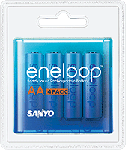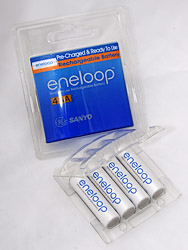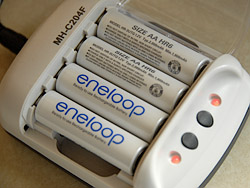READY-TO-GO RECHARGEABLE HOLDS ITS CHARGE
AA Batteries -- The Eneloop Solution
 By MIKE PASINI
By MIKE PASINIEditor
The Imaging Resource Digital Photography Newsletter
Review Date: December 2007
We're about 10 years into the digital photography revolution (depending on what birthday you count) and the NiMH rechargeable AA battery is still going strong. It's still found in some entry-level cameras as well as long zoom digicams where its capacity and convenience are still admired.
More compact but proprietary lithium-ion cells have managed to pack enough power for 150 to 300 shots, but they're not as easy to find as a set of AAs. And they aren't inexpensive either, so buying a spare and keeping it charged is less common than having a spare set of AAs.
But lithium ion cells have had one big advantage over AA battery technology. You can charge them and let them sit a while before you use them without the charge draining away. With NiMH AA batteries, you have to top them off before use because they lose much of their charge sitting around. And that can be a nuisance.

Packaging. The blister pack opens to reveal a convenient storage package for the four AA package.
That's one reason we've always recommended investing in a set of non-rechargeable lithium AAs. They aren't cheap, but they can be relied on in an emergency, holding their charge for up to 10 years. They're also a great solution for cameras you use just a few times a year.
A NEW AA | Back to Contents
But in the last year, several companies have designed NiMH rechargeables that retain a surprisingly large percentage of their charge. And just to prove it, they are selling them at retail outlets as "pre-charged and ready to use."
Our fleet of 1250, 1400 and 1600 NiMH AAs are aging, requiring more frequent recharging of their diminishing capacity. Some of the newer digicams expect a bit more juice than they can provide, so even a freshly charged set doesn't provide enough juice to power the camera up.
When we read Theano Nikitas' review of the Canon PowerShot S5, we noticed she had the same problem. "Our older NiMH batteries didn't work for more than a few seconds with the Canon S5, so make sure you get a fresh set. We switched to Sanyo's new Eneloop batteries, which promise a longer shelf life, and had no trouble."
We hiked down to the local camera store and picked up a set of four for $11.88 packed in a blister pack that doubles as a storage box. They're also available in a set of two with a charger, but any NiMH charger will work (and we already have a, um, battery of them). But a good charger makes a world of difference (delivering up to twice the charge of a lousy charger).
THE ENELOOP | Back to Contents
The GE/Sanyo Eneloop AA rechargeable has some interesting advantages over regular NiMH AA batteries:
- You can use it right away
- It packs 2000 mAh
- It loses very little charge sitting on the shelf
- It's inexpensive
You can use it right away because it holds its charge while sitting on the shelf. So there's no need to pop it in the charger for an hour or so to top it off.

Charging. No need to charge them before your first use them but you can charge them in any NiMH charger.
And because it retains "up to 85 percent" of its charge for a year, according to Sanyo, you don't have to keep it in the charger, either. That's accomplished by a new super lattice alloy which increases the electrical capacity of the battery, reduces the internal resistance and allows higher discharge currents -- all good stuff in a digicam.
They cost a bit less than a set of normal NiMHs and since you can recharge them 1,000 times, they'll outlast your equipment. If you charge them once a week (we do not), you'll be using them for over 19 years.
The 2000 mAh capacity is not state of the art (with 2600 cells available and 2500 cells common), but it is robust enough for anything out there and exceeds the more common 1800 capacity cells.
What's the difference, practically speaking? A 2300 cell may deliver about 140 minutes of power while a 2000 cell may deliver about 120 minutes of power. And 1800 cell may go 115 minutes. A 1600 about 100 minutes.
But mAh is just the only number on the label. Watt-hours tell you what the cell can really do, especially in a digicam which gobbles power in big gulps. For that kind of information, you want Dave's Battery Shootout results.
DAVE'S TESTS | Back to Contents
It turns out, Dave's been testing the new technology for his Battery Shootout. He hasn't had a chance to update that seminal work yet, but we caught him at the virtual water cooler.
"The Eneloops are indeed a real innovation, and a lot of other companies have come out with cells using similar technology," he told us.
"I've tested several brands now, and they all seem to lose 12 to 15 percent of their charge in the first month after having been charged. Still, that's pretty good.
"Their most important difference though, is that the Eneloops appear to have much lower internal resistance, which means that their output voltage doesn't drop nearly as much when they're hit with a sudden current load. This in turn makes them much better at running 'finicky' cameras that give only very short run times on conventional NiMHs.
"In a non-finicky camera, conventional 2500-2700 mAh cells will power them a lot longer than Eneloops will, as the Eneloops are only rated at 2000 mAh."
WHAT WE LIKE | Back to Contents
Being able to use them right away would matter to us if we found ourselves suddenly short of power and needed to buy some cells. Normally, we'd be miffed. If we bought reusable NiMH cells, they wouldn't have any charge. If we bought alkalines, they'd be short lived. If we had to fork up some lunch money for AA lithiums, we'd at least have them a while, but they aren't cheap. So we'd go for the Eneloops because we can use them right away and recharge them later.
The 2000 mAh capacity and lower internal resistance matters, too, because they'll outlast our older batteries and spark the newer cameras. We're not using a lower capacity cell to get the other advantages.
And unlike some higher capacity AAs, the Eneloops are not significantly fatter or longer than standard AAs. They fit without straining a normal AA battery compartment's lid.
But the real thing we like about our Eneloops after a month of use is that we don't have to continually charge them to have a fully charged set. We can just leave them in the camera between shoots. We don't get a low battery warning the next time we need the camera. It still registers as a full charge a month later. Nice.
CONCLUSION | Back to Contents
The next time you need AAs, look for the white Eneloop NiMH rechargeables. They've got enough juice to power a digicam, don't have to be charged to be used and hold their charge between uses, making them the most convenient AA rechargeable you can buy. That also makes them a pretty nice gift for anyone who uses AAs. And who doesn't?